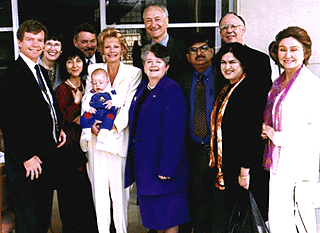![[Currents header graphic]](/homeart/currents_header.gif)
![[Currents header graphic]](/homeart/currents_header.gif)
March 2, 1998

|
|
Members of the UCSC delegation and their spouses were guests of the Honorable Richard Celeste, the U.S. ambassador for India, and his wife for a luncheon.
|
In early January a delegation from the campus traveled to India. The trip was an overture to what will be a rich variety of multidisciplinary collaborations between UCSC and institutions in India.
The delegation, led by Chancellor Greenwood, conducted the trip at the invitation of the Honorable Naresh Chandra, ambassador to the United States from India; and with the assistance of Narpat Bhandari, who recently established the Chandra Bhandari Endowed Chair in India Studies at UCSC. Other delegation members were Executive Vice Chancellor Michael Tanner, assistant chancellor of University Advancement Daniel G. Aldrich III, dean of the Division of Humanities Jorge Hankamer, dean of the Division of the Arts Edward Houghton, and history professor Dilip Basu.
The delegation visited with dozens of government officials and leaders in business, arts, education, and the high-technology industry. In addition to her role as academic ambassador, Greenwood also served as a scientific expert while in India, addressing an audience of more than 1,000 at the Indian Science Congress in Hyderabad. In her talk, Greenwood discussed issues concerning scientific collaboration between India and UCSC. Following her address, Greenwood met with Indian Prime Minister Inder Kumar Gujral to discuss the focus of the team's visit and potential ventures between India and UCSC.
The delegation was unanimous in its sense that the trip was a great success. "We've established strong ties with India's academic, political, and business leaders," said Chancellor Greenwood. "From these initial contacts we expect to develop a variety of academic collaborations including research partnerships, academic exchange programs, and possible distance-learning programs. With the exception of the Delhi fog, which prevented us from visiting the Taj Mahal, the trip was a complete success."
Aldrich concurred: "Our mission on this trip was to explore the possibilities for collaboration and to build bridges. That was the primary agenda and it was accomplished in full. We identified individuals of great stature who are interested in joining forces, discovered opportunities for our faculty and students to work and study in India at an array of institutions, and identified potential means for funding these various projects."
Among the many institutions the delegation visited were: the Indian Institute of Technology, Delhi, the National Film Development Corporation, IBM India, Texas Instruments of India, Central University in Hyderabad, the American Studies Resource Center, the Tata Institute for Fundamental Research, the Indira Gandhi Institute for Developmental Studies, Hindustan Computers Limited, the New Delhi office of the Ford Foundation, the Indira Gandhi National Centre for the Arts, the United Nations India Development Program, the United States Information Service, Calcutta University, Visva Bharati University, India Institute of Science in Bangalore, and the National Institute of Advanced Studies, also in Bangalore.
"Education is highly valued in India," noted Hankamer. "The country has a broad network of world-class educational institutions and there is a high demand for quality education there. Among the potential collaborative efforts we've identified is a project to deliver instruction to students in India through distance-learning technology."
Another project the delegation explored extensively is the development of academic exchange programs, according to Houghton. "We discussed a number of programs with representatives from the U.S. Information Service and the Fulbright Commission. Of interest were a fellowship-in-arts program that would exchange performers and graphic artists for three- to six-month periods; a program for sending American high school and university teachers to India for 8 to 12 weeks; and Central University, Hyderabad's "Study India" program.
According to Tanner, "Our mission on this trip was to explore potential avenues of collaboration and to meet with those who would lead these efforts from India. The warm reception we received and the enthusiasm we encountered was heartening."
Basu, who helped significantly to organize the trip, echoed Tanner's enthusiasm. "The trip was a tremendous success. It is so important, as we become more of a global community, for our leaders to have firsthand knowledge of the cultures with which we interact, and it was my pleasure and privilege to accompany our campus leaders on this trip. Additionally, I was struck on this trip by the amazing wealth of resources we discovered, and not just in India studies, but in the sciences, technology, the arts."
Another outcome of the trip is that many of those who hosted and met with the UCSC delegation are looking forward to coming to our campus, Basu said. And many are expected to attend and participate in an October conference on the global economy, environment, and technology. That conference will be presented with support from the Bhandari Chair and is scheduled for the 1998-99 academic year.